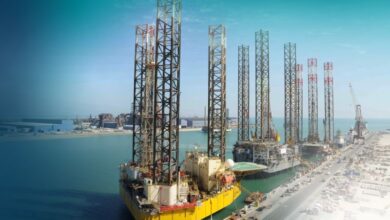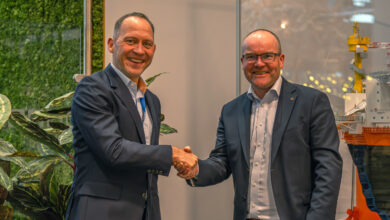Research reveals new thinking and industry trends in human factors, operational resilience
Data suggests organizations must go beyond compliance to develop adaptive workforce capable of navigating uncertainty at all levels
By David A. Wilbur and Kari R. Strobel, Vetergy Group
The world is evolving at an unprecedented pace, and with it, the complexities of modern operational environments. Traditional human performance models, which focus on error avoidance and prescriptive control, are no longer sufficient. Advanced systems now surpass human intellect and fail in complex ways, demanding a new framework that accounts for multidimensional interactions and systemic influences.
Companies must cultivate an environment where teams can anticipate, adapt and recover from abnormalities. Operational resilience is defined as the capacity of an organization’s people to adapt their responses to changing system conditions through normal decision making to produce desired business outcomes. Having a strategic focus on operational resilience ensures that organizations not only withstand challenges but thrive in the face of uncertainty. Far from being just a buzzword, operational resilience is the linchpin that connects structured safety measures with the ability to adapt and respond effectively.
Operational resilience enables individuals to make sound decisions in both routine and high-pressure situations, ensuring organizations can navigate uncertainty and perform at their peak. Bridging the gap between safety as planned and safety as performed requires developing human capacity for adaptation and sound judgment. Risk is an inherent feature of complex, dynamic systems, not just the result of individual mistakes. Treating it as such obscures true causes and stifles learning. Organizations must move beyond blame and compliance. Instead, they need safety frameworks that foster systemic resilience and adaptive capacity, equipping teams to anticipate risks and respond effectively rather than simply follow rules.
Rethinking safety in modern systems
Legacy safety models focus primarily on error avoidance and component reliability. While these are essential, they fail to address the broader context. Modern large-scale systems integrate technical, structural and social dimensions, requiring a shift from reductionist safety paradigms to holistic resilience strategies. A comprehensive safety model must recognize that a systemic drift toward risk is natural and requires proactive management.
While traditional intervention strategies focus on the individual (e.g., re-training or reprimanding), operationally resilient organizations include interventions to address the system, fostering a learning culture where adaptive strategies replace rigid, compliance-driven approaches. This holistic systems approach is reflected in organizations that successfully balance safety, production and workforce alignment and engagement. By cultivating resilience through adaptive performance, proactive management and sound judgment, leaders can ensure that safety strategies evolve to meet the complexities of modern operational environments.
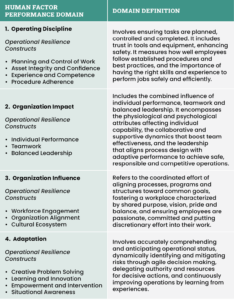
Industries face mounting pressures from compressed decision cycles, labor shortages and heightened financial risks in high-consequence scenarios. Traditional safety approaches – built around strict compliance and procedural discipline – can unintentionally increase risk or create unsafe conditions when established protocols diverge from actual operating environments. To build resilience, organizations must prioritize sound judgment over blind adherence to rules and foster a culture of continuous learning and improvement. Effective safety management requires dynamic, ongoing reassessment and adaptation. Cultivating resilient safety leaders who empower teams to navigate change and make informed decisions under pressure is critical.
Aligning adaptive strategies with shared organizational goals strengthens safety culture, while leveraging diverse perspectives through collaboration reveals risks and opportunities that might otherwise go unnoticed.
Building resilience through human-centered strategies
A holistic systems approach recognizes individuals, teams and the organization as an interconnected whole, where leadership alignment, culture and teamwork guide every decision. By integrating proactive problem solving, continuous learning and cross-functional collaboration with operating discipline, these elements drive adaptive performance. Together, they bridge the gap between design reliability and real-world operations, creating a responsive and resilient framework that sustains safety, efficiency and profitability.
To uncover gaps in the traditional way human performance is understood and managed, a rigorous mixed-method research approach was taken that incorporates both quantitative and qualitative data collection. By analyzing data from Vetergy Group’s Operational Resilience Index alongside in-field observations and direct interviews with operators, leaders and key stakeholders, strengths and opportunities were explored across 14 operational resilience constructs within four human factor performance domains (Table 1).
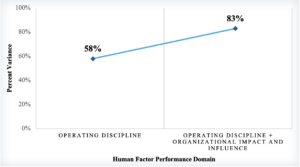
Participants from nine heavy industries — including energy, oil and gas, petroleum refining, power and utilities, manufacturing, construction, mining and pharmaceuticals and biotech – provided diverse perspectives on operational resilience. Representing roles ranging from non-management front-line staff to senior leaders, their insights were analyzed against a composite adaptive performance score. This evaluation revealed direct and indirect patterns and trends, informing strategies to enhance performance and strengthen resilience and operational effectiveness.
This evidence-based approach validates the reliability of the model, providing organizations with practical, targeted tools to bridge the gap between operating discipline and the complexities of real-world operational demands. The outcome is an advanced human performance model that drives measurable improvements and cultivates sustainable resilience within high-risk industries.
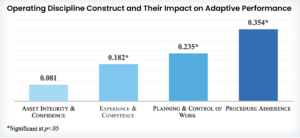
Impact of system dynamics on operational resilience and the capacity to adapt
The research findings reveal that traditional safety measures, on their own, do not adequately predict an organization’s ability to adapt. Industry data shows that operational design contributes just 58% to adaptive capacity, highlighting the limitations of relying solely on failure prevention and automation, which may lead to a false sense of security. In contrast, incorporating organizational dynamics – such as leadership, teamwork and cultural influence – significantly enhances human adaptability. This optimization drives an 83% improvement in adaptive capacity, resulting in safer, more productive and highly competitive operations (Figure 1).
The study analyzed the direct and indirect effects of operational resilience constructs, evaluating their contributions to improved performance and adaptability. Among the constructs that directly influence operating discipline’s impact on adaptive capacity, asset integrity emerged as a relatively minor driver, contributing only 8% to design reliability. While asset integrity remains important, it represents the smallest opportunity to drive adaptation. Its ability to enhance safety performance is limited unless investments into asset integrity are integrated with broader organizational strategies. Simply maintaining assets is insufficient – aligning these efforts with design and cultural initiatives is essential for enhancing safety and adaptability (Figure 2).
In contrast, procedure adherence stood out as the most significant contributor within operational design, carrying the greatest weight. Operators and managers strongly agreed that adherence to procedures is a cornerstone of operating discipline, contributing 35% to optimizing design reliability and enhancing adaptability. However, procedural adherence on its own is not enough; organizational influences are essential to ensuring that procedures are applied effectively to achieve desired outcomes.
Analyzing the indirect impact of organizational-level constructs on adaptive capacity through operating discipline, individual performance was found to contribute only 1% to overall operational performance improvements. This finding underscores the dominant influence of the broader organizational environment. Among all factors, organizational culture emerged as the most critical determinant of operational resilience, enhancing the impact of design reliability on performance by 20%. This highlights that “the way we do things around here” is pivotal to fostering adaptive and high-performing organizations.
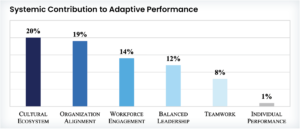
Balanced leadership and teamwork also play vital roles in navigating change and fostering a culture of continuous learning. Organizations with robust leadership structures and engaged teams demonstrated a greater capacity to anticipate and address operational risks. Teamwork draws on diverse perspectives to strengthen safety measures and reinforce a proactive approach to problem solving (Figure 3).
Resources in the right place predict performance gains
Navigating the ever-changing landscape of dynamic operations requires agility and foresight. Insights from high-risk industries underscore the significant role organizational factors play in driving and predicting performance gains. Effectively allocating resources across the organization not only strengthens safety culture but also enhances adaptability.
The research highlights the incremental impact of these performance drivers, with organizational alignment emerging as a critical factor. Alignment ensures adaptive strategies remain focused. Furthermore, a well-structured and adaptable safety culture is essential for building resilience, promoting continuous learning and adaptation and empowering teams to respond proactively to emerging risks.
Teamwork, leveraging diverse perspectives, is pivotal in improving safety measures and fostering collaborative problem solving. Complementing this, balanced leadership serves as a key driver in navigating change and fostering innovation. Strong leadership structures cultivate an engaged workforce that is proactive and vigilant, reinforcing an organization’s ability to anticipate and mitigate risks. This engaged workforce, in turn, improves safety performance through clear communication, proactive behaviors and heightened situational awareness (Figure 4).
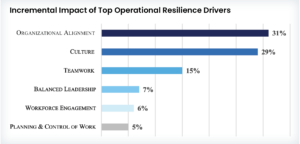
In an era of increasing complexity and uncertainty, investing in operational resilience has evolved from being a strategic initiative to an essential requirement for sustainable success. The research highlights that resilience extends beyond merely mitigating disruptions — it fundamentally enhances business operations by addressing the intricate system dynamics that underpin adaptive performance. Organizations that prioritize adaptability foster safer and more efficient operations by equipping employees with the tools, training and decision-making autonomy needed to navigate uncertainty.
Aligning resilience strategies with broader organizational objectives fortifies a culture of safety and adaptability. Effective planning and work control mechanisms empower proactive responses to emerging threats, while fostering an environment of continuous learning ensures agility in the face of change. Moreover, sound judgment emerges as a critical cornerstone of operational success, underscoring that resilience and adaptability are essential for effectively managing complex and high-risk environments. While procedural adherence remains vital, it must be complemented by real-time adaptability to achieve sustained operational success.
A call for transformational change
Operational resilience necessitates a fundamental shift in how organizations approach human performance. Traditional compliance-driven safety models, which depend solely on rule adherence and static metrics, are no longer sufficient in today’s dynamic operational environments. To thrive, organizations must adopt a holistic, learning-centered approach that recognizes risk as an inherent feature of complex systems.
By embedding resilience into daily operations, organizations can develop an adaptive workforce capable of navigating uncertainty with agility. Achieving this transformation requires systemic analysis, the adoption of adaptive strategies and a steadfast commitment to a culture of continuous improvement. Leaders play a pivotal role in driving this change, ensuring that safety, operational effectiveness and workforce engagement are aligned and mutually reinforcing.
Ultimately, operational excellence hinges on an organization’s ability to cultivate sound judgment, foster adaptive leadership and instill resilience at every level.
By embracing these principles, organizations can transform operational resilience from an aspiration into a measurable reality — one that drives safer, more efficient and sustainable operations. DC
Click here to view a video interview with Vetergy’s David Wilbur.

